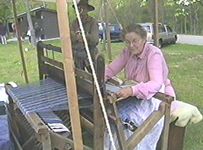Collection Production: Audio and Video Productions
 There are various types and levels of video production. Today, a digital video camera and iMovie software allows anyone to make high quality video projects.
There are various types and levels of video production. Today, a digital video camera and iMovie software allows anyone to make high quality video projects.
You are undoubtedly familiar with “slick” professional productions as seen daily in our network television programming, the 30-second commercials that try to sell you everything from soap to sausage, and your favorite music videos. On the other end of the video production spectrum are amateur home videos that all-to-often move from scene to scene too rapidly, zoom in-and-out from the action to the point of producing vertigo and nausea effects, and contain wide extremes of lighting conditions and audio quality.
On this page, you'll learn how to produce quality informational and instructional videos. Of course, they won't be perfect, but you aren't spending a million dollars to produce them either. If you use the techniques we discuss, your videos will be effective and appealing.
Types of Video Production
Video productions at the professional level can be categorized as studio or field production programs. The first type is recorded in specially-equipped studio rooms featuring multi-camera support that are usually integrated together with lighting and sound systems feeding into mixing and control board panels. These units are linked with an effects generator and connected to recorders and monitors housed in the studio control room. In these studio productions, most of the program is put together in “real-time” and recorded onto master tapes or broadcast “live” as the event unfolds. If the studio production is being recorded for future playback, post-production techniques can be used to add specific program elements such as voice-over narration and graphic elements, titling, and credits. Your favorite television shows and commercials are probably recorded in a studio.
On the other hand, field production programming involves the “raw” video footage first being gathered on-location by single camera recording. This video footage is then brought to a video editing facility and assembled into its final playback version. In the editing facility it is possible to electronically add together music and audio voice-over effects, bring in varied video clips, and add graphics, titling, and effects. This editing is done in much the same way as post-production activities for studio productions. Many of the television news programs use this approach in their productions.
The type of video production that is most commonly available for the K-12 classroom or public library is single-camera production without the support of any video editing or post-production facilities. Sometimes called "guerrilla" video production, such programming can still contain high-quality content and incorporate professional technical levels. Even though production is limited to a single video camera, programs can still be made that contain high quality visual and audio content. In addition, these productions have the added benefit of having been developed to meet specific local instructional needs, a strength that often carries the production above any lowered technical quality that the program contains.
 Guerrilla video productions require the producers to carefully plan, prepare, and produce their programs keeping the technical limitations of video production in mind. Although the final product won't have the glitz of a Hollywood production, single-camera productions can be both interesting and contain good instructional content quality.
Guerrilla video productions require the producers to carefully plan, prepare, and produce their programs keeping the technical limitations of video production in mind. Although the final product won't have the glitz of a Hollywood production, single-camera productions can be both interesting and contain good instructional content quality.
On the right is a still shot from a guerrilla video created by some students on a field trip to a "Settler's Day" festival. Students took video of living history exhibits and interviewed people about their crafts and trades.
Uses of Locally Produced Video
Guerrilla video programs are completed in libraries and schools for varied purposes. The programs are usually produced by students, teachers, or student/teacher teams. Sometimes other groups, such as parents and school administrators, initiate or become involved in creating a video program. Most productions are the result of combined efforts. Some are thoughtful productions, while others are nothing more than spontaneous video shoots. Student productions are sometimes made for a classroom assignment, as part of a portfolio entry, to record an event, or as a segment of a video yearbook. Teacher productions are often created to deliver instruction, to record a class for an absent or homebound student, to facilitate individual or small-group instruction, to provide a video “field-trip”, to eliminate unnecessary repetition in demonstrating a procedure or completing an experiment, or just to record an event. The most common instructional videos are step-by-step instruction, instances of presenting procedures, and teaching a process.
![]() Create a list of the types of videos you'd like to produce. What special events or other activities could be recorded? What's the value of videos?
Create a list of the types of videos you'd like to produce. What special events or other activities could be recorded? What's the value of videos?
![]() Explore the possibilities in your school or library. Do you have video cameras available? Are they analog (VHS) or digital? Do you have a computer with a firewire drive? What about a video digitizing card? Do you have any software for editing video such as iMovie or MGI Video Wave?
Explore the possibilities in your school or library. Do you have video cameras available? Are they analog (VHS) or digital? Do you have a computer with a firewire drive? What about a video digitizing card? Do you have any software for editing video such as iMovie or MGI Video Wave?